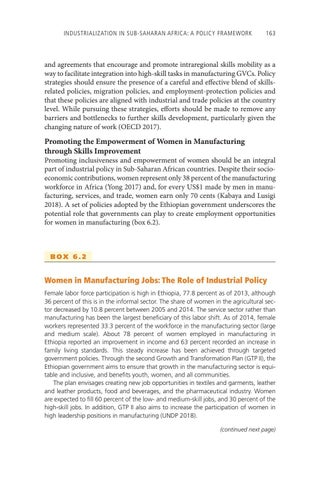INDUSTRIALIZATION IN SUB-SAHARAN AFRICA: A POLICY FRAMEWORK 163
and agreements that encourage and promote intraregional skills mobility as a way to facilitate integration into high-skill tasks in manufacturing GVCs. Policy strategies should ensure the presence of a careful and effective blend of skillsrelated policies, migration policies, and employment-protection policies and that these policies are aligned with industrial and trade policies at the country level. While pursuing these strategies, efforts should be made to remove any barriers and bottlenecks to further skills development, particularly given the changing nature of work (OECD 2017).
Promoting the Empowerment of Women in Manufacturing through Skills Improvement
Promoting inclusiveness and empowerment of women should be an integral part of industrial policy in Sub-Saharan African countries. Despite their socioeconomic contributions, women represent only 38 percent of the manufacturing workforce in Africa (Yong 2017) and, for every US$1 made by men in manufacturing, services, and trade, women earn only 70 cents (Kabaya and Lusigi 2018). A set of policies adopted by the Ethiopian government underscores the potential role that governments can play to create employment opportunities for women in manufacturing (box 6.2).
BOX 6.2
Women in Manufacturing Jobs: The Role of Industrial Policy Female labor force participation is high in Ethiopia, 77.8 percent as of 2013, although 36 percent of this is in the informal sector. The share of women in the agricultural sector decreased by 10.8 percent between 2005 and 2014. The service sector rather than manufacturing has been the largest beneficiary of this labor shift. As of 2014, female workers represented 33.3 percent of the workforce in the manufacturing sector (large and medium scale). About 78 percent of women employed in manufacturing in Ethiopia reported an improvement in income and 63 percent recorded an increase in family living standards. This steady increase has been achieved through targeted government policies. Through the second Growth and Transformation Plan (GTP II), the Ethiopian government aims to ensure that growth in the manufacturing sector is equitable and inclusive, and benefits youth, women, and all communities. The plan envisages creating new job opportunities in textiles and garments, leather and leather products, food and beverages, and the pharmaceutical industry. Women are expected to fill 60 percent of the low- and medium-skill jobs, and 30 percent of the high-skill jobs. In addition, GTP II also aims to increase the participation of women in high leadership positions in manufacturing (UNDP 2018). (continued next page)

